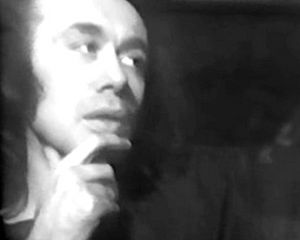Vito Acconci facts for kids
Quick facts for kids
Vito Acconci
|
|
|---|---|

Acconci in 1973
|
|
| Born |
Vito Hannibal Acconci
January 24, 1940 New York City, U.S.
|
| Died | April 27, 2017 (aged 77) New York City, U.S.
|
| Education | College of the Holy Cross University of Iowa |
| Known for | Landscape architect Installation art Performance art Video art |
Vito Acconci (born January 24, 1940 – died April 27, 2017) was an important American artist. He started out making performance art and video art. Later, his work grew to include sculpture, architectural design, and even landscape design. Many artists, like Laurie Anderson and Tracey Emin, were inspired by his ideas.
Acconci first loved poetry. But by the late 1960s, he began creating unique performances. These often happened on the street or for small groups. In the late 1970s, he started making bigger works like sculptures and architectural designs. He created public artworks, parks, and even artificial islands. These projects often invited people to join in, change things, and have fun.
Some of his famous public works include: Personal Island in the Netherlands (1994), Walkways Through the Wall in Milwaukee, WI (1998), and Murinsel in Graz, Austria (2003). His art has been shown in major museums like the Museum of Modern Art in New York. He also received many awards for his work. Besides creating art, Acconci taught at many colleges and universities. He passed away in 2017 at the age of 77.
Contents
Vito Acconci's Artistic Journey
Early Life and Learning
Vito Hannibal Acconci was born in The Bronx, New York City, in 1940. He went to Catholic schools for elementary, high school, and college. He earned a degree in literature from the College of the Holy Cross in 1962. Then, he got another degree in literature and poetry from the University of Iowa. He once said that he never had a woman in his classroom until graduate school. After finishing his studies, he returned to New York City to become a poet.
From Poetry to Performance Art
Acconci began his career as a poet. In the late 1960s, he edited and published a poetry magazine called 0 TO 9 with Bernadette Mayer. They printed about 100 to 350 copies of each issue. The magazine featured works by both poets and artists.
Later in the 1960s, Acconci changed his focus. He became a performance and video artist. He used his own body in his art, which he captured through photography, film, and video. Much of his early work had strong social messages. His performances often challenged people and were influenced by a movement called Situationism. By the mid-1970s, Acconci started creating audio and visual installations.
Creating Permanent Art and Designs
In the 1980s, Acconci began making permanent sculptures and installations. He often invited people to interact with his art. For example, some of his works involved machines that viewers could activate to create shelters or signs. One well-known temporary installation was Instant House, first made in 1980. It was shown again in 2012 at the Museum of Contemporary Art San Diego.
In 1983, Acconci created Way Station I (Study Chamber). This was his first permanent installation. It showed a big change in his career, moving from performance art to architectural design. In the late 1980s, he started designing furniture and ideas for houses and gardens. In 1988, he started Acconci Studio in Brooklyn. This studio focused on designing and building new ideas. Acconci Studio designed the United Bamboo store in Tokyo in 2003. They also worked on interactive art vehicles. One of their most famous projects is the Murinsel in Graz, Austria. Acconci focused on designing buildings and landscapes that mix public and private spaces.
Projects in the 2000s
One of Acconci's later works is Lobby-for-the-Time-Being. This art piece has been in the North Wing Lobby of the Bronx Museum of the Arts since 2009. It fills the lobby with a white, wavy structure that looks like giant paper snowflakes.
In 2010, Acconci finished Waterfall Out & In. This is a water feature at the visitors' center of the Newtown Creek Wastewater Treatment Plant in Greenpoint, Brooklyn. Part of the waterfall is inside the building, and part is outside.
In 2013, his work Way Station I (Study Chamber) was reinstalled at Middlebury College. This piece had been damaged and removed in 1985. In 2014, Acconci talked in a video about some of his favorite projects that were never built. These included a Skatepark in San Jose, California and a museum of needles in Ichihara, Chiba. He believed that unbuilt projects can help us think about what might come in the future.
Teaching and Legacy
Vito Acconci taught art and design at many colleges and universities. Some of these include the Nova Scotia College of Art and Design, San Francisco Art Institute, California Institute of the Arts, Cooper Union, School of the Art Institute of Chicago, Yale University, and Pratt Institute. Before he passed away, he taught at Brooklyn College and was an Adjunct Associate Professor at Pratt Institute.
Acconci was married to artist Rosemary Mayer in the 1960s. He passed away on April 28, 2017, at the age of 77. He is survived by his wife, Maria Acconci.
Images for kids
See also
 In Spanish: Vito Acconci para niños
In Spanish: Vito Acconci para niños
- Murinsel
- Conceptual art




